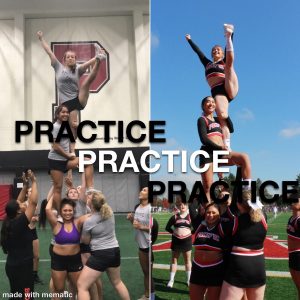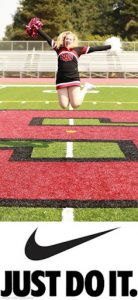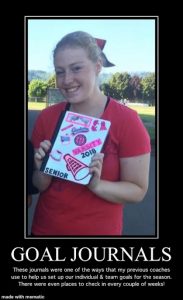12
Whitney Groeger
In the previous two chapters, we have discussed how influential coaching can be in a cheerleader’s life in the long term. Here’s the breakdown of how you can be a good coach and what the psychological “do’s and don’ts” are of the cheerleading world.
“Do!”: Make sure that you teach each team member’s strengths! Although all athletes are capable of learning in a variety of ways, some may be stronger or prefer a particular way. If you can provide information in a multitude of ways you can reach cheerleaders where they are at. This can include emails with reminders, videos of cheers/dances, Google Docs or PDF’s of cheers, etc. The great thing about today’s day in age is that just about all of your athletes and parents of athletes have access to technology so utilize this! A great app that my coaches have used the past few years is the BAND app. The app has the ability to post homework material (dances, cheers, game day tapes, etc), attach google docs of words, a calendar of what the season is going to look like, post song material, chat with your athletes and best of all…team photos! If you haven’t already I would be sure to check this out! I know for me this app has helped me to not only be able to communicate with my coaches quickly and efficiently but it has also helped me to organize all things cheer because it’s all in one place!
 “Don’t!”: Expect all your athletes to learn at the same pace! I know for me I learn better with face-to-face instruction but even still it takes quite a bit of repetition to get the material sunk in; for others, watching a video may be all they need to solidify a routine or cheer, it all just depends. Everyone learns things a little bit different and it’s important to stress to your cheerleaders how much you believe in their abilities. Be sure to reinforce this by giving feedback in a positive light, one great way to do this is by simply believing in your athletes. What I mean by this is that it’s important to give feedback in a way that stresses that although the athlete may not have met the standard or expectation that they CAN get to this place of achievement but they simply just aren’t there yet. When you encourage your athletes in this way it boosts your athletes’ confidence as they will begin to see failures or trials as simply learning experiences rather than a place to give up. (Kleinknecht, Embracing Embodiment 2014).
“Don’t!”: Expect all your athletes to learn at the same pace! I know for me I learn better with face-to-face instruction but even still it takes quite a bit of repetition to get the material sunk in; for others, watching a video may be all they need to solidify a routine or cheer, it all just depends. Everyone learns things a little bit different and it’s important to stress to your cheerleaders how much you believe in their abilities. Be sure to reinforce this by giving feedback in a positive light, one great way to do this is by simply believing in your athletes. What I mean by this is that it’s important to give feedback in a way that stresses that although the athlete may not have met the standard or expectation that they CAN get to this place of achievement but they simply just aren’t there yet. When you encourage your athletes in this way it boosts your athletes’ confidence as they will begin to see failures or trials as simply learning experiences rather than a place to give up. (Kleinknecht, Embracing Embodiment 2014).
“Do!”: Understand the significance of labels within the context of cheerleading. Labels can be both detrimental and helpful but either way, they are inevitable! Although it can be helpful to some to say things like “we are all on the same team here!” It can also be detrimental if an individual feels that they do not belong to the group. As a coach it is best to focus on the act of participating in cheer rather than on being cheerleaders. Let the athletes take the lead in owning their labels. Inevitably your cheerleaders will come to identify with the label but let that be in their own time and in their own way instead of simply assigning it to them. Once your athletes are older and have developed this positive alignment with the identity then you can discuss being cheerleaders with them, until then be cautious of how you label your athletes because if done improperly this can lead to feelings of disclusion. As a coach, understanding the value and importance of these specific labels and societal expectations that follow is so important in helping your athletes to figure out their way through them. For example, we have all heard the stereotype that cheerleaders are “skinny” for many girls this may feel completely out of their control, and in many cases it is! Instead, help your athletes to redirect their goals and expectations of themselves to be something more attainable like “strong” or “athletic”. Changing the label from being something of a negative connotation to something that can be achieved with hard work and effort will not only change your cheerleader’s motivations but also can impact their confidence in the long run! Growth-mindsets thrive in the world and you have the power as a coach to bolster and fuel these growth-related thought patterns! (Kleinknecht, Labels on the Brain 2012).
“Don’t!”: Overuse Identity markers! While it may come from a place of good intent to say something like “we’re all cheerleaders here!” or “good job you athletes!” be careful with this! While using labels like this can be helpful to some, it will most likely be detrimental to most. Instead of telling your athletes that they are, in fact, athletes let them come to that conclusion themselves! Instead, focus on things that are action-based such as “we condition to be stronger!” or “let’s learn our cheers!”. When you take the identity out of the equation you give your cheerleaders the freedom and liberty to take ownership of their labels thus boosting self-worth and confidence in the long-run. (Lei, Green, Leslie, & Rhodes, 2019).
“Do!” Know your cheerleaders’ motivation styles. As a coach, it is very important to understand what motivates and drives your athletes. Knowing this can help you to understand how to best meet your cheerleader’s needs. Some athletes tend to be more intrinsically motivated while others may need that extra bit of incentive to keep on schedule with getting game-day ready. As a coach, you have the power to utilize these motivations to your advantage. While some cheerleaders may be motivated by simply being allowed to perform others may thrive under the guise of sparkly pom poms or honorable titles. Ultimately as a coach, you want your athletes to internalize their motivations but that is something that is out of your control; it is something that the athlete must build themselves. However, what you do have a bit of control over is external factors. Although the external motivations are not as psychologically powerful as intrinsic ones, the extrinsic motivator (i.e. sparkly pom poms) can be a good starting point in getting there. The biggest part in motivation is to capture your audience. If you can engage with an athlete in a way that can satisfy an external want (social or otherwise) your athletes will more successfully be able to move into intrinsic motivations (motivation that stems from personal values, goals and identities). (Eccles & Wigfield, 2002).
“Don’t!”: Be afraid to follow through! If you set an expectation such as benching them if they don’t know the material by a given deadline, then follow through with your end if you don’t see that there was progress. Being a coach is a balancing act of both being the “good cop” and the “bad cop” all in one. While I know you may feel very strongly about getting all of your athletes out in the game or performance, they have to learn to meet you in the middle. I know this may come off quite harsh but I promise your athletes will benefit from some tough love in the long run. Once you have laid out the expectations, handed out material, given constructive criticism and been there to be a “cheerleader” for your athletes by believing in them, there is really nothing more you can do as a coach; the ball (or in this case pompom) is in their court. Kids need to learn to be resilient! This is such an important thing to learn not only as an athlete but within life! If you simply hand it to your cheerleaders then they won’t learn to earn it. One lesson that has always stuck with me throughout my years of cheerleading is that being a part of a team is a privilege that I continually have to earn, it is not a right. I have to earn my place on the team by doing my personal best and if I can’t do that then that is on me and coaches have every right to cut me at any given time. Now I don’t say that to say that I am scared that I am going to be cut every day at practice or that I won’t ever have an off day, I’m only human, but what I can’t stress enough is that I do my best to earn my place every day. This realization has come from many years of having to work hard for what I get. So stick with your guns and not only have them try out every year but also have them prove to you that they deserve their spot on the team, I promise although sometimes it may hurt in the short-term it will payout in the long-run. High expecting teams produce high achieving athletes, allow this to shine through in your team’s performance.
“Do!”: Know how to encourage healthy self-efficacy within your cheerleaders! To review, self-efficacy is the level of belief that one has in themselves to accomplish a task. As a coach, you can boost this process by giving a demonstration, direct instruction, have them practice and then self-evaluate. Setting up an environment with the following steps will provide a place for your athletes to thrive.
Step 1) Demonstrate! This demonstration is best done if you can have more experienced athletes show what the stunt or skill is supposed to look like. This is one of the many reasons why cheerleading camp is so important if you can get your team there! At camps there will be instructors who will not only be able to give pointers on how to execute a given skill but also demonstrate in real time what a skill looks like. But as great as camp is I know sometimes getting there is just not an option for a multitude of reasons. That being said there isn’t cause to lose hope, youtube videos can work in a similar way to demo! While youtube videos are obviously not the same they can still be similarly effective in showing material.
Step 2) Direct Instruction! This means that you give your athletes exact feedback on what stance they need in order to execute a given skill. For example when stunting be sure to teach your side-bases to keep their feet shoulder width apart and keep their hands in the proper position to be the most successful. Or for tumbling if they need to squeeze their ankles together make sure to say that. As long as you give this instruction in a positive manner your cheerleaders should take well to instruction.
 Step 3) Do the skill and evaluate! Like Nike says “Just Do It!”. Much of the cheerleading world is learned through trial and error. I know the first time I put a girl in the air I definitely didn’t do it right and I can almost relive the panic I felt trying to catch her! I cannot stress how normal this is. This is a place in our sport where your athletes will be forced to learn resiliency. Keep encouraging your cheerleaders to try until they get it right! Each time they try again, ask what they think they could’ve done better in order to make the skill work. If they kinda look at you like “I don’t know” then feel free to step in with more pointers. This practice paired with self-evaluation in between can help to make the stunt or tumbling skill stronger. That being said, do be sure always that your athletes are safe about the skills they are trying to perform and if it gets to a point where they are executing something in a manner that could hurt themselves or someone else, stop and redirect the behavior. Safety is of the utmost importance!
Step 3) Do the skill and evaluate! Like Nike says “Just Do It!”. Much of the cheerleading world is learned through trial and error. I know the first time I put a girl in the air I definitely didn’t do it right and I can almost relive the panic I felt trying to catch her! I cannot stress how normal this is. This is a place in our sport where your athletes will be forced to learn resiliency. Keep encouraging your cheerleaders to try until they get it right! Each time they try again, ask what they think they could’ve done better in order to make the skill work. If they kinda look at you like “I don’t know” then feel free to step in with more pointers. This practice paired with self-evaluation in between can help to make the stunt or tumbling skill stronger. That being said, do be sure always that your athletes are safe about the skills they are trying to perform and if it gets to a point where they are executing something in a manner that could hurt themselves or someone else, stop and redirect the behavior. Safety is of the utmost importance!
Step 4) Encourage your athletes! Above all else believing in your athletes is one of the most helpful things you can do as a coach. Especially during step three, your athletes are going to get frustrated and discouraged, it’s your job to keep their spirits up! Be sure to express exactly how much you believe in them and when they do accomplish the skill, let them know how proud of them you are! The more you can be your athletes’ cheerleader, the more successful they will be. (Eccles & Wigfield, 2002).
“Don’t!”: Let your frustrations show! As a coach it is so vital to try and keep your reactions as positive as possible. Although this may be hard, do your best to try and mask your frustrations. If you need to have your kiddos take a water break while you take a deep breath, do it! Yelling at your athletes in a negative manner never accomplishes anything. When you yell at your athletes all they will hear is the anger and not what skill you are trying to fix. When you do need to reprimand, however, use a stern tone with precise and clear language to get your point across; this way the expectation is made clear and there can be a chance for your athlete to redeem themselves instead of feel poorly for their mistakes. When adolescents feel bad about an action this can increase the likelihood of learned helplessness. While I won’t get into this phenomenon, the quick and dirty of it is this: when children are repeatedly unsuccessful at a skill and feel poorly about it, this can lead the child to simply give up on the given task. This is something that you will want to steer away from with your team. You know what your team is capable of, don’t let your frustrations get in the way of this!
“Do!”: Be sensitive to your young athletes! I know that as an adult in charge you are constantly reminded of what a hard time adolescents go through but it’s true! This can be a time of identity crisis for many and being aware of this is very important. To review, identity crisis in adolescence is a time in which your athletes may feel very unsure of themselves. This can be due to a multitude of reasons, social, academic, etc. While your athletes are going through this stage it is important to be a lifeline for them. I know for me that through my struggles in high school (and a little bit now in college) to figure out myself I always had cheer to fall back on. It was and still is the place where I always felt the most “me” that I could be without any crazy expectations. Try not to stress your athletes out too much! Some of this is inevitable, but for the most part try to allow your practice space to be a place of healing and restoration from the rough expectations that late adolescents bring to your athletes. Although there isn’t concrete evidence that exercise helps with mental health, many (including myself) can say that they personally believe that exercise is good for the soul. However studies have shown that physical activity can lead to enhanced executive function and self regulation which has been shown to lead to improved mental health. That said, the way in which you shape the environment for your athletes can take away from these potential benefits of exercise. If you present too much information at once to your athletes, this can become overwhelming and stressful. A little bit of stress is good but too much can lead to feelings of frustration and incompetence; your athletes are already under gratuitous amounts of stress (as is the nature of adolescence) so be mindful of this and set your expectations accordingly. (Tomporowski & Pesce, 2019).
 “Don’t!”: Be afraid to push your athletes! Just like everything else in life your cheerleaders will need a gentle push in order to achieve growth. To do this, give your cheerleaders small goals that can lead to a bigger goal. For example if there is a cool pyramid you would like your cheerleaders to execute but they just aren’t quite there yet, set your sights on a smaller pyramid that will teach them the base-line skills to eventually achieve the desired goal. Small achievements will lead to feelings of success and confidence in a given skill and will allow your athletes to feel good about moving onto a more difficult task. Allow your athletes to be a part of this process! Where do they want to see their team by the end of the season? This will allow not only skills to improve but also allow your cheerleaders to take ownership in their team! This ‘small-goal tactic’ is one that your athletes can take with them into the real world! By teaching them to take things in bite sized chunks, it will allow them to not be as overwhelmed and thus more successful in the long run. (Eccles & Wigfield, 2002).
“Don’t!”: Be afraid to push your athletes! Just like everything else in life your cheerleaders will need a gentle push in order to achieve growth. To do this, give your cheerleaders small goals that can lead to a bigger goal. For example if there is a cool pyramid you would like your cheerleaders to execute but they just aren’t quite there yet, set your sights on a smaller pyramid that will teach them the base-line skills to eventually achieve the desired goal. Small achievements will lead to feelings of success and confidence in a given skill and will allow your athletes to feel good about moving onto a more difficult task. Allow your athletes to be a part of this process! Where do they want to see their team by the end of the season? This will allow not only skills to improve but also allow your cheerleaders to take ownership in their team! This ‘small-goal tactic’ is one that your athletes can take with them into the real world! By teaching them to take things in bite sized chunks, it will allow them to not be as overwhelmed and thus more successful in the long run. (Eccles & Wigfield, 2002).
Final Remarks
As I write this paper I want to put a disclaimer out there that everything that I have discussed may not be the best solution for your team. Every team is so different and one method may work super well in one gym or school and be not so great in another, it all just depends. The great thing about psychology is it is applicable within so many different contexts but it also isn’t an exact science (as much as we want it to be). What I really hope that you the coach/reader take out of this article is how to be a better coach to many different lived experiences, motivations and emotional states and how to implement wise-interventions within your coaching methods. Wise-Interventions are the advice and actions that we can do in our day to day lives with the backing of psychological science in order to better ourselves and the people around us. Wise-interventions can lead to self-enhancement, and within the context of cheerleading a better team. Sometimes when boosting self enhancement it’s the situation that needs to change, and other times it’s the individual beliefs that need adjusting; ultimately it’s a coach’s job to figure out where those pressure points are within their team and proceed accordingly. Thus I hope this paper has enlightened you to the psychological and cognitive aspects of your team in order for you to do so in an educated way that can leave a lasting impact on your athletes. Adolescence can be a rough time but as a coach you get the honor and responsibility to be a part of one of the most important times in your cheerleaders’ lives! As a cheerleader for many years (this next season will be my 13th year which is crazy!) I can’t even express how grateful I am for all of my wonderful coaches who have impacted my life. The way that they made me feel valued, wanted and capable is something that has made me not only a better athlete but a better person. I hope that you too can be a stepping stone in these long-lasting character developments for your athletes and forever be their “cheerleader” as they go on to do great things not only on your team, but in life.

References
Eccles, J. S. & Wigfield, A. (2002). Motivational beliefs, values, and goals. Annual Review of Psychology, 53, 109 – 132.
Kleinknecht, E. (2014, January 18). Embracing Embodiment. Cognitioneducation. https://cognitioneducation.me/2014/01/18/embracing-embodiment/
Kleinknecht, E. (2012, February 24). Labels on the Brain. Cognitioneducation. https://cognitioneducation.me/2012/02/24/labels-on-the-brain/
Lei, R. F., Green, E. R., Leslie, S. J., & Rhodes, M. (2019). Children lose confidence in their potential to “be scientists,” but not in their capacity to “do science”. Developmental Science, 22, https://doi.org/10.1111/desc.12837
Tomporowski, P. D., & Pesce, C. (2019). Exercise, sports, and performance arts benefit cognition via a common process. Psychological Bulletin, 145(9), 929.https://doi.org/10.1037/bul0000200
